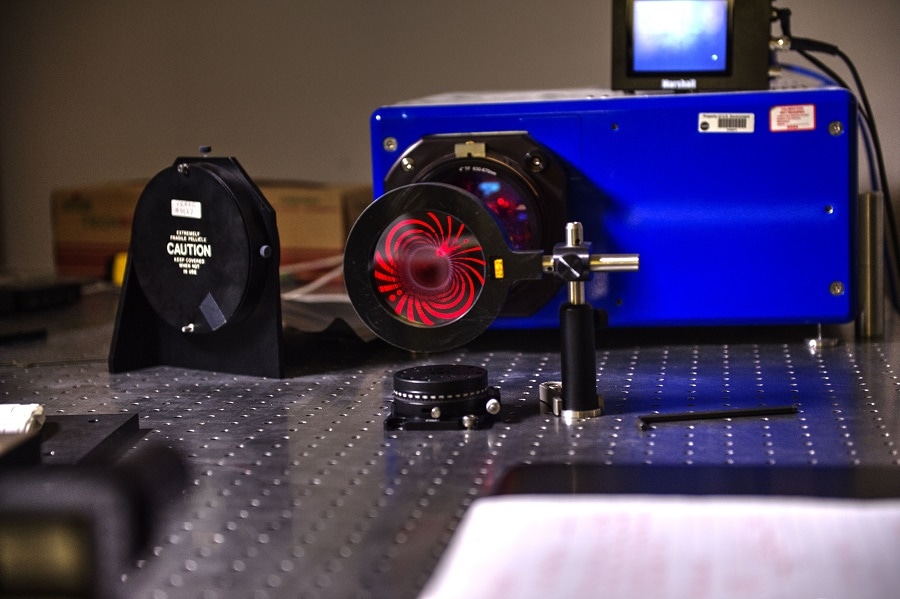Jul 27 2016
It is a well-established fact that larger light-collecting mirrors will be required by scientists to resolve smaller physical details of faraway celestial objects. However this challenge is not simple to overcome due to the high cost and difficulty of building and launching large-aperture telescopes – in this particular scenario, space observatories.
 This image shows how the photon sieve brings red laser light to a pinpoint focus on its optical axis, but produces exotic diffraction patterns when viewed from the side. Photo Credit: NASA/W. Hrybyk
This image shows how the photon sieve brings red laser light to a pinpoint focus on its optical axis, but produces exotic diffraction patterns when viewed from the side. Photo Credit: NASA/W. Hrybyk
Researchers and engineers at NASA’s Goddard Space Flight Center in Greenbelt, Maryland, have started investigating a potentially more economical substitute known as a photon sieve. This new telescope optic potentially has the capacity to offer scientists with the resolution they require to view finer details, which cannot be viewed with current observing tools. This breakthrough in resolution could help to solve a 50-year-old query regarding the physical processes heating the million-degree corona of the sun.
Though it can be potentially used at all wavelengths, the team aim to specifically develop the photon sieve for research of the sun in the UV, which is the wavelength required to unravel the coronal heating mystery. The team were able to fabricate three sieves with assistance from Goddard’s Research and Development program. Now, they plan to start testing to check if it can endure the rigors of operating in space - milestones accomplished in less than one year.
This is already a success.
Dr. Doug Rabin, NASA
Variant of Fresnel Zone Plate
The optic is an alternative of something known as a Fresnel zone plate. Instead of focusing light like most telescopes via reflection or refraction, Fresnel plates cause light to diffract, which is an occurrence where light travels through a narrow opening and then disperses. This causes the light waves on the other side to support or cancel each other out in precise patterns.
Fresnel plates comprise of a strongly spaced set of rings, alternating between transparency or opaque. Light travels through the spaces between the opaque zones, which are precisely spaced to enable the diffracted light to overlap and focus at a specific point, forming an image that can be recorded by a solid-state sensor.
The photon sieve functions in a similar manner, however the sieve is dotted with numerous holes, placed precisely on silicon in a circular pattern that takes the place of traditional Fresnel zones.
The team aims to develop a photon sieve no less than three feet, or one meter, in diameter, which is a size they feel may achieve up to 100 times better angular resolution in the UV, compared to NASA’s high-resolution space telescope; the Solar Dynamics Observatory.
For more than 50 years, the central unanswered question in solar coronal science has been to understand how energy transported from below is able to heat the corona. Current instruments have spatial resolutions about 100 times larger than the features that must be observed to understand this process.
Dr. Doug Rabin, NASA
Rabin believes his team is on the right track in constructing an optic that can help answer the query.
Millions of Holes
Within a few months the team were able to develop three devices measuring three inches wide - five times larger than the original 17 mm optic built four years ago under a previous R&D-funded endeavor. Each device possesses 16 million holes whose sizes and locations were established by team member Adrian Daw. Another team member, Kevin Denis, then etched the holes in a silicon wafer to Daw’s exacting specifications with a fabrication method known as photolithography.
Team members Anne-Marie Novo-Gradac and John O’Neill have obtained optical images using the new photon sieves, while Tom Widmyer and Greg Woytko have prepared them for vibration testing to ensure they can endure harsh g-forces encountered during launch.
This testing is to prove that the photon sieve will work as well as theory predicts.
Dr. Doug Rabin, NASA
Although the team has already achieved almost all of the goals they had planned when the research commenced towards the end of last year, Rabin believes the team can expand the optics by a factor of two by the end of the fiscal year.
Formation-Flying CubeSat
However, the research will not stop there. In the nearer term, Rabin believes his team can advance the technology for a potential sounding-rocket display. In the longer term, he and team member Joe Davila foresee the optic flying on a two-spacecraft formation-flying CubeSat-type mission built particularly to analyze the sun’s corona.
The scientific payoff is a feasible and cost-effective means of achieving the resolution necessary to answer a key problem in solar physics.
Dr. Doug Rabin, NASA